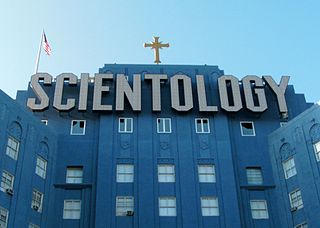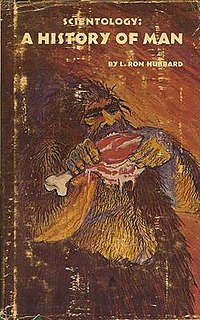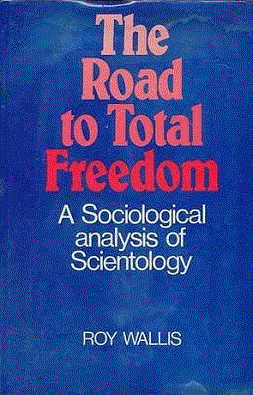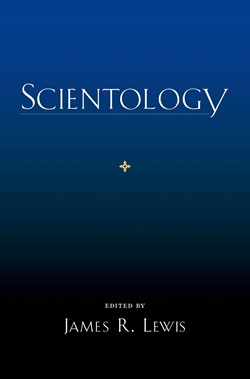
Lafayette Ronald Hubbard was an American author of science fiction and fantasy stories, and the founder of the Church of Scientology. In 1950, Hubbard authored Dianetics: The Modern Science of Mental Health and established a series of organizations to promote Dianetics. In 1952, Hubbard lost the rights to Dianetics in bankruptcy proceedings, and he subsequently founded Scientology. Thereafter Hubbard oversaw the growth of the Church of Scientology into a worldwide organization.

The Cult Awareness Network (CAN) was an organization created by deprogrammer Ted Patrick that provided information on groups that it considered to be cults, as well as support and referrals to deprogrammers. It was founded in the wake of the November 18, 1978 deaths of members of the group Peoples Temple and assassination of Congressman Leo J. Ryan in Jonestown, Guyana, and was shut down in 1996. Its name and assets were later bought by a group of private donors in bankruptcy proceedings; with the transfer of ownership, the organization was renamed the New Cult Awareness Network.
The Church of Scientology says that a human is an immortal, spiritual being (thetan) that is resident in a physical body. The thetan has had innumerable past lives and it is observed in advanced Scientology texts that lives preceding the thetan's arrival on Earth were lived in extraterrestrial cultures. Based on case studies at advanced levels, it is predicted that any Scientologist undergoing auditing will eventually come across and recount a common series of events.

Since its inception in 1954, the Church of Scientology has been involved in a number of controversies, including its stance on psychiatry, Scientology's legitimacy as a religion, the Church's aggressive attitude in dealing with its perceived enemies and critics, allegations of mistreatment of members, and predatory financial practices, for example the high cost of religious training:191 and perceived exploitative practices. When mainstream media outlets have reported alleged abuses, representatives of the church have tended to deny such allegations.

The Sea Organization is a Scientology organization, which the Church of Scientology describes as a "fraternal religious order, comprising the church's most dedicated members". All Scientology management organizations are controlled exclusively by members of the Sea Org. David Miscavige, the de facto leader of Scientology, is the highest-ranking Sea Org officer, holding the rank of captain.
Revolt in the Stars is a science fiction film screenplay written by Scientology founder L. Ron Hubbard in 1977. It tells the space opera story of how an evil galactic dictator, named Xenu, massacres many of his subjects by transporting them to Earth and killing them with atomic bombs. L. Ron Hubbard had already presented this story to his followers, as a true account of events that happened 75 million years ago, in a secret level of Scientology scripture called Operating Thetan, Level III. The screenplay was promoted around Hollywood circles in 1979, but attempts at fundraising and obtaining financing fell through, and the film was never made. Unofficial copies circulate on the Internet.

Stephen A. Kent, is a Professor in the Department of Sociology at the University of Alberta in Edmonton, Alberta, Canada. He researches new religious movements, and has published research on several such groups including the Children of God, the Church of Scientology, and newer faiths operating in Canada.

Church of Scientology founder L. Ron Hubbard included space opera narratives in his writings, wherein thetans were reincarnated periodically over quadrillions of years, retaining memories of prior lives, to which Hubbard attributed complex narratives about life throughout the universe. The most controversial of these myths is the story of Xenu, to whom Hubbard attributed responsibility for many of the world's problems.

Bare-faced Messiah: The True Story of L. Ron Hubbard is a posthumous biography of Scientology founder L. Ron Hubbard by British journalist Russell Miller. First published in the United Kingdom on 26 October 1987, the book takes a critical perspective, challenging the Church of Scientology's account of Hubbard's life and work. It quotes extensively from official documents acquired using the Freedom of Information Act and from Hubbard's personal papers, which were obtained via a defector from Scientology. It was also published in Australia, Canada and the United States.

A Piece of Blue Sky: Scientology, Dianetics and L. Ron Hubbard Exposed is a 1990 book about L. Ron Hubbard and the development of Dianetics and the Church of Scientology by British former Scientologist Jon Atack. The title originates from a quote of Hubbard's from 1950, when he was reported as saying that he wanted to sell potential church members a "piece of blue sky."

Scientology: A History of Man is a book by L. Ron Hubbard, first published in 1952 under the title What To Audit by the Scientific Press of Phoenix. According to the author, it provides "a coldblooded and factual account of your last sixty trillion years." It has gone through many editions since its first publication and is a key text of the Church of Scientology. The book has been ridiculed by critics of Scientology for its unusual writing style and pseudoscientific claims; it has been described as "a slim pretense at scientific method ... blended with a strange amalgam of psychotherapy, mysticism and pure science fiction; mainly the latter."
This is an incomplete bibliography of Scientology and Scientology-related books produced within the Church of Scientology and its related organizations, containing all of the Basic Books and some other later works either compiled from other works by or written directly by L. Ron Hubbard.
The relationship between Scientology and other religions is very complex. While Scientology claims that it is fully compatible with all existing major world religions and that it does not conflict with them or their religious practices, there are major differences in beliefs and practices between Scientology and most religions, especially the major monotheistic religions. Members are not allowed to engage in other similar mental therapies or procedures, religious or otherwise. However, some ministers from other churches have adopted some Scientology secular programs.

Scientology is a body of religious beliefs and practices invented in May 1952 by American author L. Ron Hubbard (1911–86). Hubbard initially developed a program of ideas called Dianetics, which was distributed through the Dianetics Foundation. The foundation soon entered bankruptcy, and Hubbard lost the rights to his seminal publication Dianetics: The Modern Science of Mental Health in 1952. He then recharacterized the subject as a religion and renamed it Scientology, retaining the terminology, doctrines, the E-meter, and the practice of auditing. Within a year, he regained the rights to Dianetics and retained both subjects under the umbrella of the Church of Scientology.
Scientology founder L. Ron Hubbard described Scientology as "the Western Anglicized continuance of many earlier forms of wisdom", and cites the teachings of Jesus among belief systems of those "earlier forms". Jesus is recognized in Scientology as part of its "religious heritage," and "is seen as only one of many good teachers."
Scientology in the United Kingdom is practised mainly within the Church of Scientology and its related groups which go under names including "Hubbard Academy of Personal Independence" and "Dianetics and Scientology Life Improvement Centre". The national headquarters, and former global headquarters, is Saint Hill Manor at East Grinstead, which for seven years was the home of L. Ron Hubbard, the pulp fiction author who created Scientology. Church-connected groups promoting aspects of L. Ron Hubbard's teaching, including Narconon and CCHR, have also been active in the UK, in some cases with charitable status. There have also been groups practising Scientology independently of the Church.

Scientology was founded in the United States by science fiction author L. Ron Hubbard and is now practiced in many other countries.

The Road to Total Freedom: A Sociological Analysis of Scientology is a non-fiction book about Scientology by sociologist Roy Wallis. Originally published in 1976 by Heinemann, it was republished in 1977 by Columbia University Press. The original manuscript was the product of Wallis's doctoral research at Oxford under the tutelage of Bryan Wilson. Wallis, after a review of the original manuscript by Scientology leaders, made edits to about 100 passages before publication.
The "New Cult Awareness Network" is an organization that provides information about cults, and is owned and operated by associates of the Church of Scientology, itself categorized in many countries as a cult. It was formed in 1996, with the name purchased from the now defunct Cult Awareness Network, an organization that provided information on groups it considered to be cults, and that strongly opposed Scientology.
This article discusses scientology and gender.











